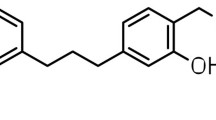Abstract
WR319691 has been shown to exhibit reasonable Plasmodium falciparum potency in vitro and exhibits reduced permeability across MDCK cell monolayers, which as part of our screening cascade led to further in vivo analysis. Single-dose pharmacokinetics was evaluated after an IV dose of 5 mg/kg in mice. Maximum bound and unbound brain levels of WR319691 were 97 and 0.05 ng/g versus approximately 1,600 and 3.2 ng/g for mefloquine. The half-life of WR319691 in plasma was approximately 13 h versus 23 h for mefloquine. The pharmacokinetics of several N-dealkylated metabolites was also evaluated. Five of six of these metabolites were detected and maximum total and free brain levels were all lower after an IV dose of 5 mg/kg WR319691 compared to mefloquine at the same dose. These data provide proof of concept that it is feasible to substantially lower the brain levels of a 4-position modified quinoline methanol in vivo without substantially decreasing potency against P. falciparum in vitro.



Similar content being viewed by others
References
Briand V, Bottero J, Noël H, Masse V, Cordel H, Guerra J, Kossou H, Fayomi B, Ayemonna P, Fievet N, Massougbodji A, Cot M (2009) Intermittent treatment for the prevention of malaria during pregnancy in Benin: a randomized, open-label equivalence trial comparing sulfadoxine-pyrimethamine with mefloquine. J Infect Dis 200:991–1001
Cairns M, Gosling R, Carneiro I, Gesase S, Mosha JF, Hashim R, Kaur H, Lemnge M, Mosha FW, Greenwood B, Chandramohan D (2010) Duration of protection against clinical malaria provided by three regimens of intermittent preventive treatment in Tanzanian infants. PLoS One 5:e9467
Centers for Disease Control (2008) CDC health information for international travel. Elsevier, Atlanta
Dow GS, Heady TN, Bhattacharjee AK, Caridha D, Gerena L, Gettayacamin M, Lanteri CA, Obaldia N 3rd, Roncal N, Shearer T, Smith PL, Tungtaeng A, Wolf L, Cabezas M, Yourick D, Smith KS (2006) Utility of alkylaminoquinolinyl methanols as new antimalarial drugs. Antimicrob Agents Chemother 50:4132–4143
Dow GS, Magill AJ, Ohrt C (2008) Clinical development of new prophylactic antimalarial drugs after the 5th Amendment to the Declaration of Helsinki. Ther Clin Risk Manag 4:803–819
Dow G, Milner E, Bhonsle J, Caridha D, Gardner S, Gerena L, Kozar M, Lanteri C, Mannila A, McCalmont W, Melendez V, Moon J, Read K, Norval S, Roncal N, Shackleford D, Sousa J, Stouten J, White K, Zeng Q, Charman S (2011) Central nervous system (CNS) exposure of next generation quinoline methanols is reduced relative to mefloquine after intravenous (IV) dosing in mice. Malar J 10:150
Gosling RD, Gesase S, Mosha JF, Carneiro I, Hashim R, Lemnge M, Mosha FW, Greenwood B, Chandramohan D (2009) Protective efficacy and safety of three antimalarial regimens for intermittent preventive treatment for malaria in infants: a randomized, double-blind, placebo-controlled trial. Lancet 374:1521–1532
Kalvass JC, Maurer TS (2002) Influence of non-specific brain and plasma binding on CNS exposure: implications for rational drug discovery. Biopharmaceutics and Drug Disp. 23:327–338
McGready R (2010) Intermittent preventive treatment of infants with mefloquine reduces risk of clinical malaria in areas of moderate malaria transmission and high resistance to sulphadoxine-pyrimethamine, but safety and tolerability issues need consideration. Evid Based Med. 15:71–72
Milner E, McCalmont W, Bhonsle J, Caridha D, Carroll D, Gardner S, Gerena L, Gettayacamin M, Lanteri C, Luong T, Melendez V, Moon J, Roncal N, Sousa J, Tungtaeng A, Wipf P, Dow G (2010a) Structure-activity relationships amongst 4-position quinoline methanol antimalarials that inhibit the growth of drug sensitive and resistant strains of Plasmodium falciparum. Bioorg Med Chem Lett 20:1347–1351
Milner E, McCalmont W, Bhonsle J, Caridha D, Cobar J, Gardner S, Gerena L, Goodine D, Lanteri C, Melendez V, Roncal N, Sousa J, Wipf P, Dow GS (2010b) Anti-malarial activity of a non-piperidine library of next-generation quinoline methanols. Malar J 11:51
Summerfield SG, Read K, Begley DJ, Obradovic T, Hidalgo IJ, Coggon S, Lewis AV, Porter RA, Jeffrey P (2007) Central nervous system drug disposition: the relationship between in situ brain permeability and brain free fraction. JPET 322:205–213
Acknowledgments
We gratefully acknowledge substantial financial support from Medicines for Malaria Venture, Military Infectious Diseases Research Program (MIDRP), and the United States Department of Defense.
Author information
Authors and Affiliations
Corresponding author
Additional information
This manuscript was reviewed by the Walter Reed Army Institute of Research and the U.S. Army Medical Research and Materiel Command, and there is no objection to its publication or dissemination. The opinions expressed herein are those of the authors and do not necessarily reflect the views or opinions of the Department of the Army and the Department of Defense. All animal experiments were conducted in compliance with the Animal Welfare Act and other federal statutes and regulations relating to animals and experiments involving animals and adhere to the principles stated in the Guide for the Care and Use of Laboratory Animals (National Academy Press, 1996). The MDCK permeability assays were performed under contract by Absorption Systems (Exton PA).
Electronic supplementary material
Below is the link to the electronic supplementary material.
Rights and permissions
About this article
Cite this article
Milner, E., Sousa, J., Pybus, B. et al. Characterization of in vivo metabolites of WR319691, a novel compound with activity against Plasmodium falciparum . Eur J Drug Metab Pharmacokinet 36, 151–158 (2011). https://doi.org/10.1007/s13318-011-0047-8
Received:
Accepted:
Published:
Issue Date:
DOI: https://doi.org/10.1007/s13318-011-0047-8




